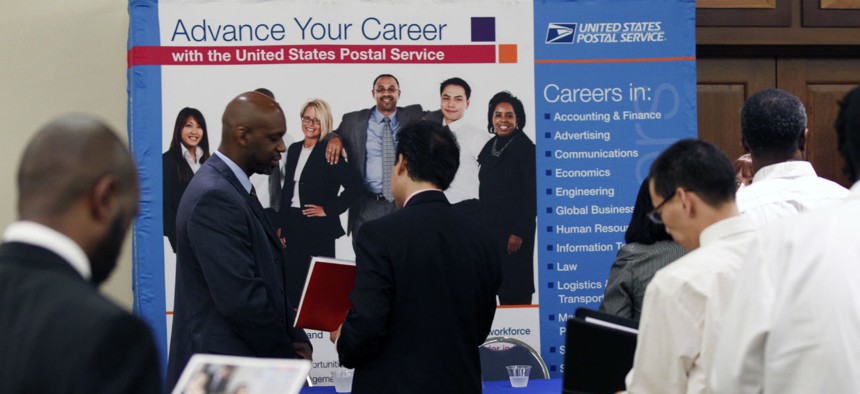
In this Aug. 4, 2011 photo, job seekers line up at the U.S. Postal Service booth during a career job fair in Arlington, Va. Jose Luis Magana/AP
Viewpoint: How a Broken Pay System Forced Postal Supervisors to Take USPS to Court
The U.S. Postal Service has a serious middle management problem.
In late July, the National Association of Postal Supervisors filed a federal lawsuit against the U.S. Postal Service, challenging its administration of the pay system that covers approximately 50,000 managers and supervisors. It is the first time in nearly 45 years that NAPS, on behalf of the postal managers and supervisors it represents, has sued the Postal Service over pay.
NAPS went to court because the Postal Service has violated the law’s requirement that it pay managers and supervisors a salary comparable to the pay of their private sector counterparts and that it pay them more than the workers they supervise. These managers and supervisors help to assure the prompt and efficient delivery of mail and the reliability of postal operations. Without a “supervisory differential” in pay, the incentive of craft workers to become supervisors is sorely undermined, and without compensation comparable to the private sector, the Postal Service cannot recruit well-qualified supervisors from outside the Service.
NAPS was prompted to file the lawsuit after the Postal Service in May 2019 issued the final terms of its 2016-2019 pay package for all personnel under the Executive and Administrative Schedule (EAS), which covers the nearly 50,000 managers, supervisors and other middle-management employees who are not members of collective bargaining units. The terms of the Postal Service’s pay package were largely the same as it had first proposed in 2017, before more than a year of “consultation” with NAPS’s leaders and before a review by a three-member fact-finding panel convened in 2018 at NAPS’s request by the Federal Mediation and Conciliation Service. The fact-finding panel extensively reviewed the fairness of the Postal Service’s pay system for its managers and supervisors and unanimously found that the so-called “pay-for-performance” system the Postal Service had devised and applied to all postal managers and supervisors is “seriously flawed.”
Instead of accepting the panel’s recommendations, the Postal Service rejected nearly all of them, resulting in NAPS’s executive board voting unanimously to file a lawsuit contesting the Postal Service’s EAS pay policies and practices. In the lawsuit, filed in federal district court in Washington, NAPS also seeks a court ruling directing the Postal Service to recognize NAPS as a rightful representative of postmasters and EAS Headquarters and Area personnel. Unfortunately, the USPS denial of NAPS’s right to represent all EAS and postmasters is part of a continued effort by USPS executives to “divide and conquer” the EAS mid-level management ranks.
In its April 2019 factfinding report, the federal mediation panel unanimously concurred with NAPS on nearly all matters, strongly validating NAPS’s complaints about Postal Service EAS pay policies. The panel found that the Postal Service’s [pay for performance] system is “seriously flawed in that it does not accomplish its objectives or comport with the requirements of the [Postal Reorganization Act].” It also found that the Postal Service does not properly calculate the supervisory pay differential, which “has resulted in many thousands of Field EAS managers and supervisors receiving less than the Service’s own 5% target differential.” And it found that “the [pay for performance] program negatively impacts the Service’s ability to attract and retain qualified and capable supervisory and managerial personnel and fails to promote the maintenance of a well-motivated workforce.”
Experts in human resources continually stress the importance of worker engagement. Engaged workers create a positive impact on the bottom line of the enterprise, improving customer service, reducing absenteeism, and lowering accidents. The Postal Service has declined to put those principles into action, or even to become alarmed that its own Pulse Survey of the USPS workforce, conducted by Gallup, placed its employees in the bottom percentile of engaged workers in the nation. The Postal Service has taken no meaningful action despite the Gallup survey finding for the past several years that 99% of other large American companies have better employee engagement.
Postal managers and supervisors have grown increasingly frustrated over their pay and the lack of respect given by USPS executives to their role within the organization. At NAPS’s biennial national convention in August 2018, delegate frustration boiled over about the EAS PFP system that has produced years of paltry annual pay increases, including no pay raises for any EAS personnel in 2011 and 2012 and no pay raises for thousands of EAS personnel in 2015, 2017, and 2018. In contrast, all union-covered postal workers receive annual cost-of-living pay adjustments under agreements negotiated with the Postal Service. Further, unlike the rest of the agencies in the federal government, the USPS does not provide area wages or locality pay adjustments to workers in higher-cost areas, such as San Francisco, New York or Washington, D.C.
Now, a federal court will decide whether the panel was correct in finding that the Postal Service has violated—and continues to violate—the law’s requirements.
Brian J. Wagner is national president of the National Association of Postal Supervisors.
NEXT STORY: Play of the Day: More on a Potential Impeachment






